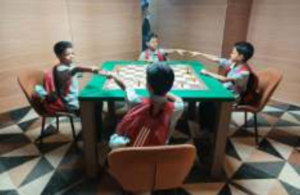Our People on the Hills
Charles Mark Correa, resident of our Hills was an Architect and Urban Planner known for his contribution towards building a post-independent modern India. He reintroduced many features of traditional Indian architecture. He wasn’t just creating physical infrastructure but also developing convenient spaces and residences that blended in with their locality & climate

He attended St. Xavier’s College, Mumbai from 1946 to 1948 before going on to study architecture at the University of Michigan (B.Arch., 1953) and (M.Arch., 1955) at the Massachusetts Institute of Technology (MIT) in USA. In 1958, he established his own professional practice in Bombay.
Correa taught at a number of universities in India and abroad, including MIT and Harvard University as well as the University of London. He was honored with Padma Shri (1972) and Padma Vibushan (2006), two of India’s highest civil honours; the Royal Gold Medal for Architecture (1984) from the Royal Institute of British Architects; the Japan Art Association’s Praemium Imperiale prize for architecture (1994) are among the many awards he received.
Correa taught at a number of universities in India and abroad, including MIT and Harvard University as well as the University of London. He was honored with Padma Shri (1972) and Padma Vibushan (2006), two of India’s highest civil honours; the Royal Gold Medal for Architecture (1984) from the Royal Institute of British Architects; the Japan Art Association’s Praemium Imperiale prize for architecture (1994) are among the many awards he received. another resident of our Hills, are credited for creating Navi Mumbai. In 1964 the Bombay Municipality published the first development plan for Greater Bombay. In 1965 Charles Correa and Shirish Patel wrote an article that Bombay was growing and suggested planned development of New Bombay. For another 5 years they both promoted this plan talking to bureaucrats and others. Finally it was a conversation with Mr. Shrinivasan, a senior bureaucrat, who ultimately convinced the then CM and CIDCO was formed in 1970 and land was acquired for development.
About the New Bombay development Mr Shirish Patel says “We did feel that the most powerful push forward for the New Bombay project would come if the government decided to shift its capital there. We said we already had an example of this being done in our own country fty years ago, when the Government of India decided to shift its capital to New Delhi. Can you imagine the chaos that would have ensued if the capital had been in old Delhi? We argued that on the mainland the city would have ample scope to expand and grow, something that was virtually impossible in South Bombay”. When we asked Mr. Patel to give a quote for Charles Correa he said “I think it is impossible for me to quote what Charles alone was saying because we worked very closely together and we were both saying the same thing. The only quotethatis exclusively Charles is “Bombay is a great city but a terrible place”. Charles Correa developed semihousing environments in the midst of overcrowded cities, in Belapur residential sector in Navi Mumbai he built independent resident units despite of the area being congested. In his urban planning commissions, he focused on low-rise units that, when combined with common spaces and facilities highlighted the contemporary style and created a sense of belonging.
In 1996, Maharashtra government set up a study group, headed by Charles Correa, to come up with an integrated development plan for mill land in the Parel. The group submitted the so called Charles Correa committee report. It proposed a three-way split: one-third of the land for public spaces that could accommodate gardens, schools and hospitals, one-third to be developed by the government for affordable housing, and one-third to be given to the erstwhile owners for residential or commercial purposes. At Sonmarg, in our neighbourhood, he successfully attempted to blend nature with architecture, this Nepean Sea Road building houses two units on each oor which each unit featuring three open sides for cross-ventilation and ample of sunlight. Kanchanjunga Apartments at Pedder Road is also the work of his architectural genius. This 32 storey building with interlocking levels hosts open terraces and offer excellent view of the South Mumbai skyline. The open terraces try to imitate the traditional Indian bungalow feature known as the veranda. Courtyards have been a part of Indian architecture since a very long time, Correa restored them to promote natural ventilation and not for aesthetic reasons. In his essay ‘A Place in the Sun’ he states that “For in a warm climate, many of a family’s most essential activities like cooking, or sleeping, or entertaining friends, do not require to take place within the four walls of a box, but can occur in verandahs, and courtyards.” Surya Kund (1986) in Delhi, the Inter- University Centre for Astrology and Astrophysics (1988–92) in Pune, and the Jawahar Kala Kendra arts complex (1986–92) in Jaipur, Rajasthan were among his later works that reected his lengthy interests. From 1985 to 1988, he was the chairman of India’s National Commission on Urbanization, and since 1999, he worked as a Consultant Architect for the Goa government.
We are happy and privileged to write this article about Charles Correa, a resident of our Hills and pride of our country. Editorial Committee of ‘The Voice of Malabar Hills’.
< Back





